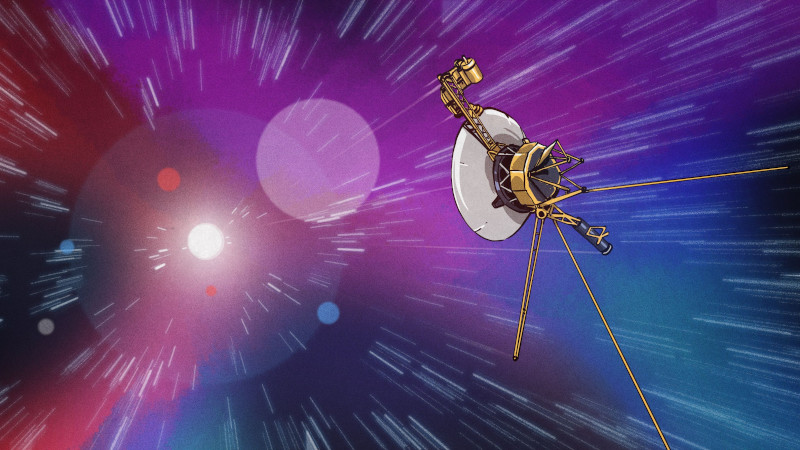- cross-posted to:
- noticias@lemmy.eco.br
- cross-posted to:
- noticias@lemmy.eco.br
That’s far out!
It is just incredible to me that we have the ability and knowhow to send instructions to a 40 year old transistor computer to reprogram itself and get it working again with just radio signals.
What they did was close to wizardry.
With no way to fix the chip, the team instead split the code up so it could be stored elsewhere. Initially they focused on reacquiring the engineering data, sending an update to Voyager 1 on 18 April 2024.
It takes 22.5 hours for a radio signal to travel the 24 billion kilometres (15 billion miles) out to Voyager 1, and the same back, meaning the spacecraft’s operations team didn’t receive a message back until 20 April.
But when it arrived, they had usable data from Voyager 1 for the first time in five months.
https://www.skyatnightmagazine.com/space-missions/how-fixed-voyager-1
Here’s a fun fact that I think of every time I read about light delay.
We assume the speed of light is the same in all directions but there’s no way to prove that it is.
It could be light speed is instantaneous in one direction, and half the speed we think it is in the reverse. Any test we could devise depends on information traveling in two directions, nullifying any discrepancies in light speed.
… but there is a way, and it has been proven.
One of the more memorable physics classes I’ve had went into the history of discoveries that led to our understanding of relativity. The relevant story here, starts with how sound travels though air.
Let’s say you’re standing at the bottom of a building shouting to your friend peeking out a window on the 5th floor. On a calm day, that friend will hear you at pretty much the same time as someone standing the same distance away, but on the street. However, if it’s windy, the wind pushes around the air through which the sound of your voice is traveling, the friend up in the window will have a slight delay in receiving that sound. This can of course be verified with more scientific rigor, like a sound sent in two perpendicular directions activating a light.
Scientist at the time thought that light, like sound, must travel though some medium, and they called this theoretical medium the Aether. Since this medium is not locked to Earth, they figured they must be capable of detecting movement of this medium, an Aether wind, if you will. If somehow the movement of this medium caused the speed of light in one direction to be faster than another due to the movement of this medium, measuring the speed in two directions perpendicular to each other would reveal that difference. After a series of experiments of increasing distances and measurement sensitivities (think mirrors on mountain tops to measure the time for a laser beam to reflect), no change in the speed of light based on direction was found.
Please enjoy this wikipedia hole: https://en.m.wikipedia.org/wiki/Michelson–Morley_experiment , and please consider a bit of caution before you refer to things as facts in the future!
As far as I’m aware, what you cited only proves that there is no ether that acts on light in a way such that the round trip time in the direction of ether travel is different from the round trip time in the direction perpendicular to ether travel.
It’s not merely that:
somehow the movement of this medium caused the speed of light in one direction to be faster than another due to the movement of this medium, measuring the speed in two directions perpendicular to each other would reveal that difference.
Instead, it’s that the speed of light must be different in the two directions in a way such that their round trip times don’t average out to the same average as in the other direction.
The theories of ether at the time predicted such a round trip difference because of the wind like interactions that you say.
I believe that this in no way proves anything about the one way speed of light. The Michaelson Morley inteferometer only measures difference in round trip time.
(Insert comment about the irony of your last statement). See https://en.m.wikipedia.org/wiki/One-way_speed_of_light
How does the double slit experiment work into this?
The speed of light in a vacuum unaffected by external forces such as gravity should be the same no matter what direction it is in. I’m not sure why it wouldn’t be. That’s like saying a kilometer is longer if you go East than if you go West.
However, it’s actually far more complicated than that, and much of it beyond my understanding.
https://math.ucr.edu/home/baez/physics/Relativity/SpeedOfLight/speed_of_light.html
That said, direction should not matter.
There’s no reason it wouldn’t be. The point is that it’s impossible to prove that it is. There is no conceivable experiment that can be performed to prove the two-way speed of light is symmetric.
That’s not how anything works. It’s impossible to prove that the universe wasn’t created last Thursday with everything in place as it is now. There’s no point in assuming anything that can’t be proven has validity.
It’s just a thought exercise. There are several reputable YouTube videos on this topic. None of them claim that the speed of light isn’t the speed of light. They’re just demonstrating that we can’t prove it with current technology. Similar to the difficulty it took to finally prove that one plus one equals two. We know that’s correct, but it took years to prove it.
…but that’s exactly what you’re doing. The fact that light travels at the same speed in all directions cannot be proven. You’re the one insisting that it does.
Another interesting way to conceptualize it is that the speed of light is infinite and it’s causality/information that is limited to c. You shine a light at the moon and it takes 1.3 seconds for the “fact” that the light was turned on to propagate that far.
Cixin Liu imagines exactly that towards the end of the Three Body series. Among other things, which make the series worth absolutely slogging through at points.
Couldn’t we send out two devices in different directions, wait a decade, have them shine light at eachother simultaneously, record when they receive the light, then send the times back to earth?
Your question is good. You’re missing understanding of time dilation and frame of reference. An explanation of the theory of relativity is at least pages long.
The first book I ever read on the subject, and IMO the best introductory text for any non-physiscist, is Stephen Hawking’s “A Brief History of Time”. But, any introduction to relativity should answer your question.
…from 15.2 BILLION miles away.
And it can reply by basically shining a (very high-frequency) flashlight back at us.
Incredible is the right word, how does this still work after more than 47 years? How do they even still have energy to send and receive signals? That’s one heck of a durable power source. How do the computers and sensors still work? The reliability and durability of these probes is amazing. NASA truly had some reality wizards doing what seems like magic to accomplish this.
Either that or, aliens have been helping out and repaired it from time to time.
How do they even still have energy to send and receive signals?
They’re apparently on their last legs now in terms of being able to keep all the instruments running.
The Voyagers have enough electrical power and thruster fuel to keep its current suite of science instruments on until at least 2025.
They’ve been on their last legs for decades now
How do they even still have energy to send and receive signals? That’s one heck of a durable power source.
It’s literally decaying plutonium-238. And because it decays, it’s putting out less power than when it started. They’ve shut down certain operations to conserve power, and obviously prioritize things like communication back to earth.
How do they even still have energy to send and receive signals? That’s one heck of a durable power source.
Nuclear power, it packs a punch!
Fuck aliens
Same. That was incredible.
47 year old probe. Damn near 50
It’s literally the most far out object there is
I’m constantly amazed at the longevity of this probe, so awesome!
it’s too bad they don’t make cellphones like this
Kinda goes against capitalism. Planned obsolescence has been around for a long time and if somebody goes against it, they will be removed by the big players.
I’m not saying planned obsolescence isn’t a thing (because it is), but that’s not the only reason. Making phones smaller, lighter, faster, and more feature-dense all mean that the phone has to be built with tighter manufacturing and operating tolerances. Faster chips are more prone to heat and vibration damage. Higher power requirements means the battery has a larger charge/discharge cycle. And unfortunately, tighter operating tolerances mean that they can fall out of those tolerances much more easily.
They get dropped, shaken, exposed to large environmental temperature swings, charged in wonky ways, exposed to hand oils and other kinds of dirt, and a slew of other evils. Older phones that didn’t have such tight tolerances could handle all that better. Old Nokia phones weren’t built to be indestructible, they are just such simple phones that there isn’t much to break; but there’s a reason people don’t use them much anymore. You can still get simple feature phones, but the fact remains that they don’t sell well, so not many are made, and the ones that are made don’t have a lot of time and money invested in them.
Now Voyager is an extremely simple computer, made with technology that has huge tolerances, in an environment that is mostly consistent and known ahead of time so the design can deliberately account for it, had lots of testing, didn’t have to take mass production into its design consideration, didn’t have to make cost trade-offs, and has a dedicated engineering team to keep it going. It is still impressive that it has lasted this long, but that is more a testament to the incredible work that was and is being put into it than to the technology behind it.
There’s also the fact that the mass market wants their cheap shit. Make something to last 10x as long at 3x the price, and sure folks will buy it but the market share would be minuscule.
Its not only that the market wants cheap shit, but also that you would need to trust a company to not just be overpriced shit
Too true
Yeah. I’d totally buy an $800 million phone.
Realistically you can buy something like a Fairphone that lets you replace most parts that wear out or get damaged, which definitely increases the overall longevity of your phone. Or that CAT phone that’s supposed to be super durable if you’re prone to breaking your phone. Or if smart phones aren’t your deal you can maybe find the old reliable Nokia 3210, that phone does not break and the battery can be replaced.
If you have phone longevity issues then stop buying phones that are not designed to be used for a long time.
How much does the plutonium battery fairphone cost these days?
Interesting about about 2k, to give a nice round number.
Voyagers is estimated to have insufficient power for communication by 2032, so from its launch we’ll get a rounded 60 year battery life. Fairphone doesn’t have plutonium batteries (though that would be pretty cool) but you can replace batteries. Let’s say you replace the battery every 2 years which means you need 30 batteries. At 40€ a piece the cost of batteries is 1200€(and you get one extra battery with the phone). Add in the cost of the phone with the delivery of phone + 30 batteries and it comes out to about 2k.
you have to charge those though, Voyager doesn’t need charged
I guess that’s the downside of not having a miniature reactor in your phone.
Honestly I’d be happy even with just user-replaceable battery so that I can swap it every year or two, and go maybe 4-5 years this way. That’s the most I’ve needed since I’ve been using a mobile phone. Beyond that a phone is bound to feel morally obsolete, unless you also replace the mainboard/chipset, which I reckon isn’t easily doable.
Luckily user replaceable batteries are coming with an EU regulation some time within the next 5 years, but so far fairphone is the most repairable phone you can have. I don’t think you can replace mobo or chipset, but it does allow replacing quite a few things. For me the 3 most important ones are battery, charging port and screen, as those are the most likely for me to get worn out or broken. I haven’t bought it yet because my current phone is still somewhat chugging along, but my next phone will definitely be a fairphone.
Fair point (ba-dum-tss), I had forgotten about that ruling, but I’m afraid that manufacturers will still find a way to weasel out of this. Let’s see.
The satellite dish would press against your hip bone.
Ah, the old Lemmy dish-a-roo.
they do work. my dad still has Nokia phone with black and white screen.
do they still make them like this? i have to buy a new pixel every few years
I cant even get a decent wifi signal from a router 15ft away from me, but somehow we’re sending and receiving data from a satellite, that’s practically outside of our solar system. Isn’t that wild?
It’s like the Jason Vorhees of spacecraft
That’s just Jason X.
I’d pay to see Voyager beat a teenager to death with another one in a sleeping bag. Sounds compelling.
V’ger has evolved
I was looking for this comment, else I would have been very disappointed
Live Long and Prosper
Anyone ever sometimes think, that there’s an alien species that kinda feels a little paternal towards us and keeps fixing out Tonka Toys because it makes us happy?
Screw thanking aliens, it’s an incredible team of engineers that have the skills and dedication to do what seems impossible. This was 100% humanity at its best.
They rebuilt the most critical core code on a near antique spacecraft that has effectively left the solar system over an equally ancient radio link. They had 1 shot, and nailed it.
Exactly. If there’s anything that we can point to and say “humanity, fuck yeah” this is it. Giving thanks to aliens or to gods is an insult to the hard work of the HUMANS that accomplished this.
Exactly. NASA has proven beyond a shadow of a doubt that there is no God, the earth is a ball, we can trust our governments and large institutions, and manned space flight was a '70s trend back when the economy was better. We still have them to thank for Velcro and Tang my dudes
Did they have eeproms in the 70s? It’s just mind blowing. These nerds are next level.
Naw, so Apollo was built with curtain rods and used candles for thrust
https://moon.nasa.gov/system/resources/detail_files/188_detail_as11-40-5927_orig.jpg
Yes ra ra NASA is totally legit and a shining example of the best achievements of humanity for sure. Nothing sketchy about it. It is amazing though to think how manned space flight is the only technology to not only lack progress in the last 60 years, but has actually regressed. I really wish these hero scientists could get back to working on manned space flight so we can ditch this whirling spaceball
This is disrespectful towards the achievements of the human race. My father kept attributing all of our recent technology to “the findings at roswell” and i have very strong feelings towards this position.
So much agreeance. I can see how people may be awestruck by recent technology, but crediting it to extraterrestrial life both completely ignores the gradual progression of knowledge which enabled it and disregards the brilliant minds who spent their lives bringing it to fruition.
Provided we engineer them well, this is good news for truly deep space operations. Cosmic radiation and interplanetary gasses could (and probably do) wreak havoc on various materials, but apparently technology from the 70s is capable of handling it very long term.
Now if we could just get out of these squishy meat suits we’d be in business.
Solid state tech using minerals and metals for interstellar travel.
Squishy meatbag for living and reproducing on a goldilocked planetoid.
We should just turn into comets for the purpose of travelling 🐌 slow but effective
I try to diagnose the carburetor in my 50 year old Jeep sitting right in front of me, and I still can’t get it running right.
These people are amazing, and the people that built that so it can still be fixed out in the Oort Cloud were even better.
Absolute Chad.
🫡
o7
Just curious: is the data of value for research or is it more like “look at us, we can repair from a distance”?
There are currently five science investigation teams participating in the VIM. The science teams for these investigations are currently collecting and evaluating data on the strength and orientation of the Sun’s magnetic field; the composition, direction and energy spectra of the solar wind particles and interstellar cosmic rays; the strength of radio emissions that are thought to be originating at the heliopause, beyond which is interstellar space; and the distribution of hydrogen within the outer heliosphere.
There are 4 operating instruments on-board the Voyager 1 spacecraft. These instruments directly support the five science investigations teams. The Planetary Radio Astronomy Investigation (PRA) is no longer working on the Voyager 1 spacecraft and the Ultraviolet Spectrometer Subsystem (UVS) is no longer working on Voyager 1 or Voyager 2.
Yes the data is valuable for research. You and I may not understand any of it, but its useful to someone. As for repairing from a distance, that thing has been traveling for 46 years and gone far. For reference, it passed Neptune back in 1989.
It would take many years for a new probe to reach those distances, so if it can be repaired, it shall.
https://en.m.wikipedia.org/wiki/Voyager_2
Hypothetically, lets say it only takes 30 years for a new probe with updated tech to reach where Voyager 2 is now. If V2 died today, thats half of someone’s career spent waiting for the new probe to arrive. Multiply that by everyone using the probe for research and you have a ton of wasted potential.
I’m aware that sending something to do the repairs isn’t an option, my question was whether it’s worth it (and apparently it is) or if it’s more an experiment about long distance repairs which by itself is very expressive already.
I’m not sure why I’m downvoted. Maybe I worded my question badly or it’s because it was a question I could have googled on my own. I don’t know and neither do I care. I don’t think you downvoted me, if it sounded that way. Just now saw it and wondered why
Remote software repairs are definatly good, pretty cool and worth bragging about. If you have to do a physical repair, you’re probably better off just sending a new probe [citation needed], but as I said the time investment is huge.
It is a legitimate question, however the way it was asked has a negative vibe, intentional or not. You pretty much gave a good option and bad option and said “pick one” - generally when that’s asked, we assume the asker assumes the negative is true (it’s hard to explain). To me, it could be interpreted as “just curious, I assume this probe is only taking pretty pictures, so why do you bother repairing it?”.
Personally, I’ve been trying to avoid jumping to those types of conclusions, but its not easy. Text has no tone, and phrases sometimes have a secondary tonal meanings that people will insert. “Just curious…was it you that didn’t refill the coffee machine this morning?”
Thanks, I’m not good at tone in my native language already and even less in English. I didn’t give the comment much thought, I could have found a better phrasing.
About the coffee machine: I refilled it today so it must have been someone else who didn’t
So some years ago, the probe went into some area between our solar system and interstellar space. Getting info back about that is quite useful in learning more about that area.
I’m not sure if its through it yet, but if it is, then we’re getting data back about what’s after that as well. Does that data change over time? What if there’s yet another transition area and we learn about it?
Having something actually there helps us know if all these theories are right, and the more data we get, the more sure we can be
How is there space between the solar system and interstellar space? Isn’t interstellar just everything between the star systems?
Out past the planets is the heliopause, the final boundary between the solar system and interstellar space. Voyager discovered it, but other probes have confirmed it. The radiation and particles emitted by the sun create a pressurized bubble around it, where plasma (energized particles, mostly hydrogen) is much denser than past the heliopause. Cosmic rays are more prevalent outside it.
I’ve heard it compared to the empty zone around where a sink faucet first hits, creating a little “wall” of water around it as the splashing water pushes back the standing water.
“Empty” space is anything but. There’s tons of particles and energy flying though it, just not as dense.
That sink analogy is great. It’s even non uniform like the heliopause
The solar winds interact with interstellar winds and create a threshold between the two
Ya not sure why you would be downvoted either. Maybe people thought you were saying NASA does things just to brag.
I’m in the positive again, maybe it was my other comment or it’s just fluctuating
Voyager 2 went with a different trajectory specifically to fly by the outer planets. Voyager 1 went with a more aggressive gravity assist from both Jupiter and Saturn to gain the speed necessary to leave the solar system. So it’s not only that it takes decades to get that far, but also the launch window of when different planets are aligned to make the mission feasible.
Considering that’s one of the two objects humanity ever have on direct contact with the medium outside the limits of our solar system, and the only tool we’ll have there for at least four decades, I’d argue that yes, it is pretty valuable.
The repair from distance part is nothing to be shy about, too.
It’s the only instrumentation we have at that distance that can measure things like solar irradiance.
Interesting question though, which sent me down a rabbit hole to see the capabilities of the instrumentation.
I like to follow it through space
People will believe anything lol

















